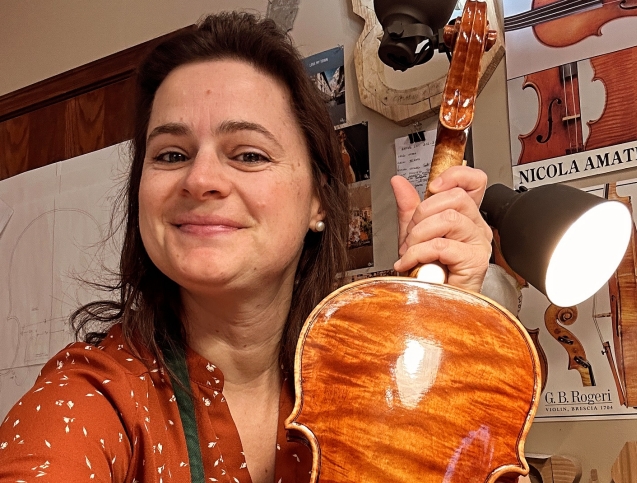The Vettori family continues its art and craft for 3 generations. They have embraced their family passion as both a lifestyle and a profession. It is a very precious thing to continue such a business for generations in a time when everything is produced in a fabricated world. For the first time in Turkey, we had a short and pleasant interview with Sofia Vettori between her busy schedule.
Can you tell us about your family and its history?
I am Sofia Vettori, born in Fiesole, Italy, now living in America. My family is unique in Italy for being three generations of continuous violin makers. My grandfather, father, brothers, uncle, and now my husband are all violin makers.
Since I was little, I accompanied my father to violin-making exhibitions and concerts. His workshop was part of our house, and we were always surrounded by the atmosphere of violin making. We played with wood chips and absorbed the workshop’s ambiance.
At 17, I decided to work with my father in the workshop. The first skill I learned was varnishing, which remains my favorite. When my mother was alive, she helped with varnishing and managed emails. It was truly a family business.
I continued my studies and earned a doctorate in archaeology. I also have a conservatory diploma in violin. Despite my studies and performances, I always worked in my father’s workshop.
How did your grandfather start the business?
My grandfather began in 1935 in Firenzuola, a small town between Florence and Bologna. He was a musician, playing the violin and conducting the town orchestra. His curiosity about how violins were made led him to open one up. With the help of books, he made his first violin, though he burned it because he was dissatisfied. He continued making violins, corresponding with makers in Florence and Bologna to improve. His determination is inspiring.
Today, with internet access, aspiring violin makers have no excuses. If you really want to do it, you’ll find a way.
What are the advantages and disadvantages of growing up in a three-generation violin-making family?
My father and uncle were not forced into the business. Growing up in a family passionate about violin making is like being constantly inspired. The workshop was part of our home, and my father now has a larger workshop in Florence. The job offers freedom of time and movement. We traveled as a family, even taking work to the seaside. It’s a good life, creating something that brings joy to others.
I prefer the Montagnana and Santo Serafino models because of the sound they produce. I also decorate my violins and give each a name, documenting them in an album. This was my unique idea. Each instrument has a label and stamp, with the name written inside. My work is recognizable by my unique arching style and scroll design.
We all do the same job, but we make our own instruments with our own labels. It’s like being a family of painters, each creating a different painting. I can tell there are significant differences between the instruments I make and those made by my father, my brothers, and my uncle. Each instrument is unique and appeals to different musicians, just like how different paintings appeal to different people. Although we all do the same job, we each create our own distinct instruments.

Have you faced criticism for your career choice?
Criticism is inevitable, but if you follow your passion, you’ll find a way to persevere. While our job isn’t as secure as traditional careers, it offers freedom and global connections. We create instruments that amplify art, beauty, and happiness.
Can you describe the production process and standards for your instruments?
I make violins, violas, and cellos with standardized measurements to ensure consistent playability across instruments. Musicians can seamlessly switch between models without needing to adjust their hand positioning, tuning, or technique. This uniform setup simplifies musicians’ experiences.
While maintaining this consistency, there are slight variations in features such as the f-hole design and the overall dimensions of the instruments. For violas, I offer different models and lengths to accommodate varying player preferences for size. However, the proportions of the neck and string length remain standardized, facilitating easy transitions between different viola sizes. This principle also applies to cellos.
I work on custom orders, allowing clients to select their preferred wood pieces. Typically, I use maple for the back, ribs, and scroll, and spruce for the top of the instruments. This approach ensures high quality and meets the specific preferences of musicians.
What is the most special instrument you have ever made? How long does an instrument last?
I don’t have different prices for different instruments as I use top-quality materials for all. The most special violin I made was from the last piece of wood from a tree my grandfather cut before I was born. I keep this violin for myself.
Instruments can last for centuries if well cared for. Historical violins from as early as the 16th century are still played today. The more precious the instrument, the better care it receives, ensuring its longevity.
Can you give examples of famous names you sell instruments to?
I sold a violin to Turkish artist Fahrettin Arda from Antalya Ballet Orchestra. He visited my workshop in Florence and loved the Domenico Montagnana model. He bought one in 2019, and we visited him in Turkey in 2022. I fell in love with Turkey, its culture, and its music.
